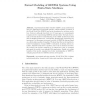Free Online Productivity Tools
i2Speak
i2Symbol
i2OCR
iTex2Img
iWeb2Print
iWeb2Shot
i2Type
iPdf2Split
iPdf2Merge
i2Bopomofo
i2Arabic
i2Style
i2Image
i2PDF
iLatex2Rtf
Sci2ools
ICWE
2011
Springer
2011
Springer
Formal Modeling of RESTful Systems Using Finite-State Machines
Representational State Transfer (REST), as an architectural style for distributed hypermedia systems, enables scalable operation of the World Wide Web (WWW) and is the foundation for its future evolution. However, although described over 10 years ago, no comprehensive formal model for representing RESTful systems exists. The lack of a formal model has hindered understanding of the REST architectural style and the WWW architecture, consequently limiting Web engineering advancement. In this paper we present a model of RESTful systems based on a finite-state machine formalism. We show that the model enables intuitive formalization of many REST’s constraints, including uniform interface, stateless client-server operation, and code-on-demand execution. We describe the model’s mapping to a system-level view of operation and apply the model to an example Web application. Finally, we outline benefits of the model, ranging from better understanding of REST to designing frameworks for REST...
Future Evolution | Hypermedia Systems | ICWE 2011 | Internet Technology | Representational State Transfer |
| Added | 29 Aug 2011 |
| Updated | 29 Aug 2011 |
| Type | Journal |
| Year | 2011 |
| Where | ICWE |
| Authors | Ivan Zuzak, Ivan Budiselic, Goran Delac |
Comments (0)

